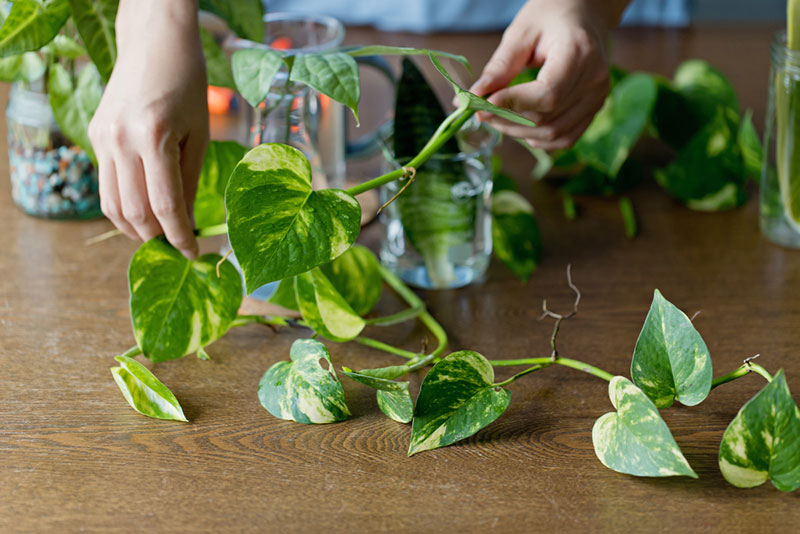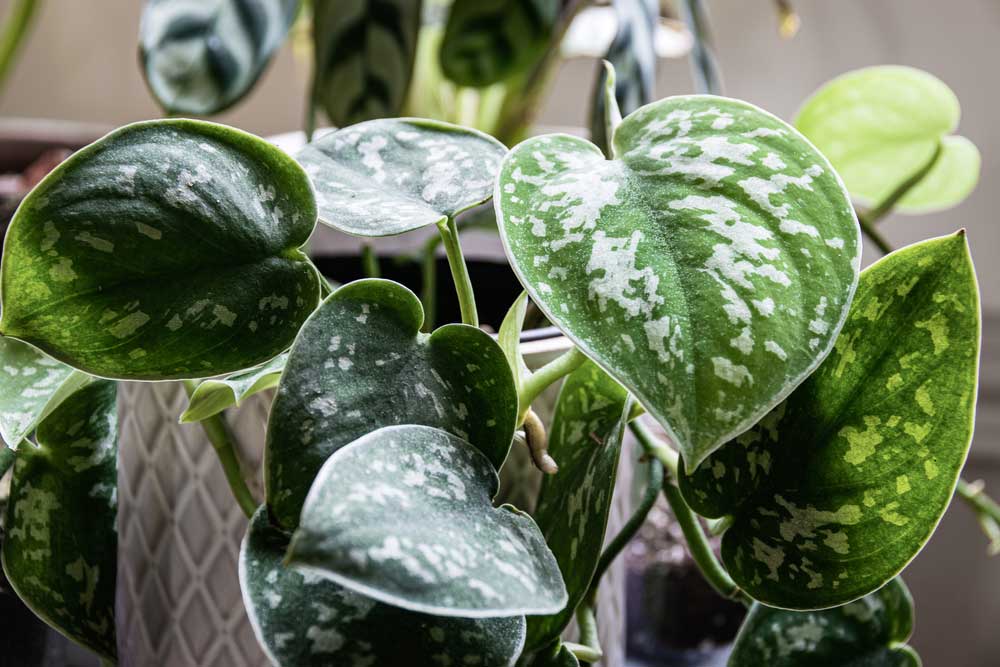
Pothos is a tropical or subtropical vining plant native to Southeast Asia and the western Pacific, where it grows under the canopy in filtered or dappled light. It is a popular houseplant throughout much of the U.S. but can be grown outside in hardiness zones 10 through 12.
As a houseplant, pothos is typically grown in hanging baskets or planters where the vines cascade over the sides, but they can be grown on a moss pole or totem. When grown upright, pothos typically reaches heights of 6 to 8 feet.
Place your pothos in a location where it receives bright, indirect sunlight, such as across the room from a western or southern window, or use a sheer curtain to filter the light.
| Botanical Name: | Epipremnum ‘aureum’ |
| Common Name(s): | Pothos, Golden Pothos, Devil’s Ivy, Taro Vine, Devil’s Vine, Ivy Arum, Marble Queen |
| Plant Type: | Perennial Tropical Vine |
| Mature Size: | 6-8 feet (houseplant) 40 feet in the wild |
| Sun Exposure: | Medium Filtered Light |
| Water Needs: | Medium |
| Soil Type: | Well-drained/ Silty |
| Soil pH: | 6.1 to 6.8 |
| Bloom Time: | Rarely Blooms |
| Maintenance: | Low |
| Leaf Color: | Green, Variegated White, Gold/Yellow, White |
| Hardiness Zones: | 10-12 |
| Toxicity: | Humans and Pets |
Light
Pothos prefer bright indirect sunlight and will suffer from direct sunlight. Either place your pothos several feet from the window or use a sheer curtain to filter the rays of the sun. If grown outside, pothos should be planted in a shaded location with little direct sunlight.
Variegated varieties need a bit more light than solid green pothos as the white or light-colored areas do not contain chlorophyll and cannot perform photosynthesis. Variegated pothos grown in low light may lose their beautiful variegation as the plant will compensate by producing more green leaves.
Water
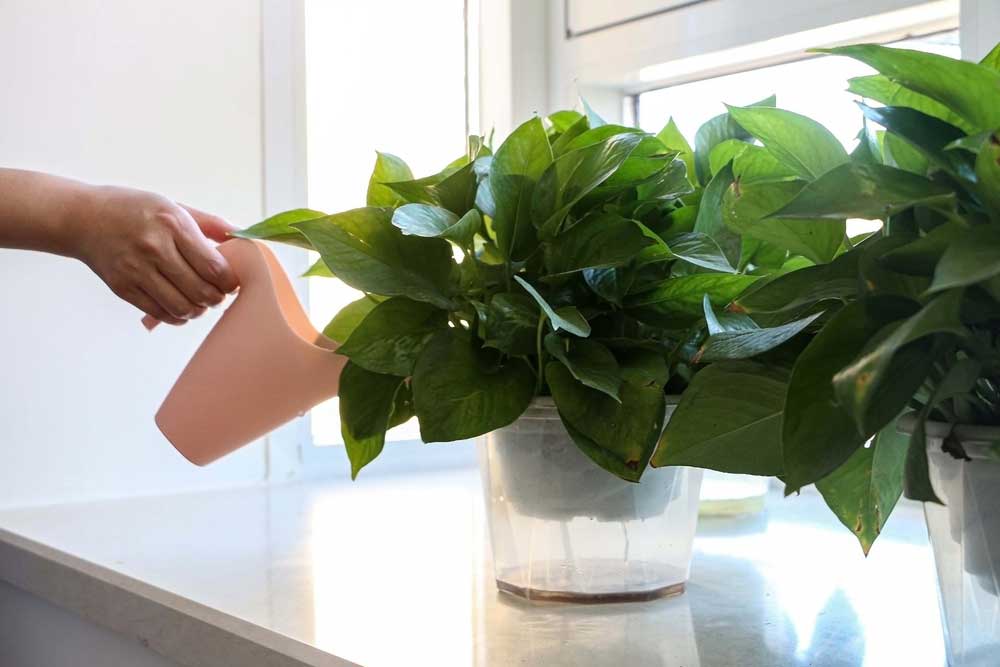
Although pothos are tropical plants, they cannot tolerate sitting in wet soil. Water your pothos when the soil feels dry to the touch an inch or two below the surface of the soil.
During the spring and summer, when your pothos is actively growing, it may require watering once a week or more. During the fall and winter, when growth slows and the plant rests, it will use less water and may not need to be watered for ten days or more.
Always check the soil’s moisture before watering your pothos plant and use that as your guide to when it needs water.
Temperature & Humidity
Pothos thrive in a wide range of temperatures but do best with temperatures between 70 and 90 degrees. Temperatures below 65 degrees may cause stress to your pothos plant. Grow your pothos in a draft-free area where temperatures remain above 65 at night.
Like other tropical houseplants, pothos like humid air. They do best with humidity levels between 60 and 90 percent. This means you will likely need to provide added moisture to the air during the winter.
Increase the humidity around your pothos plants by using a humidifier, placing the plant on a pebble tray, or grouping several houseplants together to conserve moisture. While many recommend misting your pothos plants, it really won’t raise the humidity for more than a few minutes, explains the Iowa State University Extension.
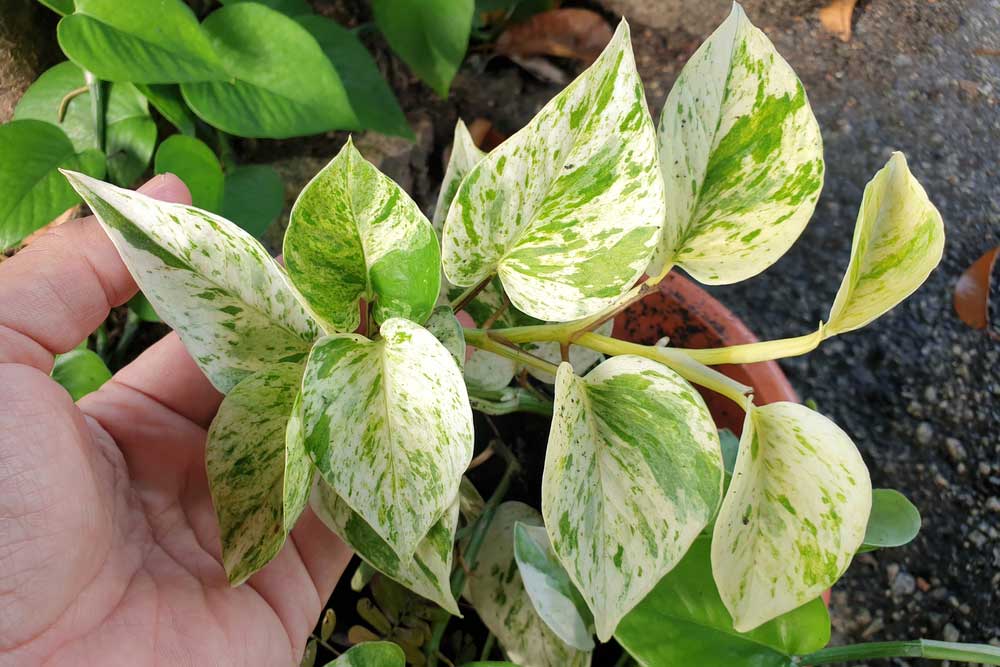
Soil
Pothos prefer well-aerated soil that drains well, as their tender roots do not tolerate soggy soil. All-purpose potting soil is too heavy and dense for your pothos plant. A mix of equal parts potting soil, peat moss, and perlite is a better choice as it keeps the soil aerated and promotes good drainage.
Fertilizer
Pothos needs a balanced fertilizer once a month from spring until fall, when it is actively growing. Some prefer to dilute the fertilizer to ½ strength and apply it every two weeks.
Stop fertilizing it in the fall when the plant growth slows. Your pothos plant needs to rest during the winter and does not need fertilizer.
Resume fertilizing your pothos plant in the spring when new growth begins.
Is Pothos Toxic?
All parts of the pothos plant contain calcium oxalate crystals which are toxic to humans and pets. Ingesting parts of the pothos plant can cause burning and irritation of the mouth, lips, tongue, and throat. Swelling may cause difficulty with breathing. Seek medical attention immediately if swelling occurs.
Contact with the sap from the foliage may also cause contact dermatitis or eye irritation.
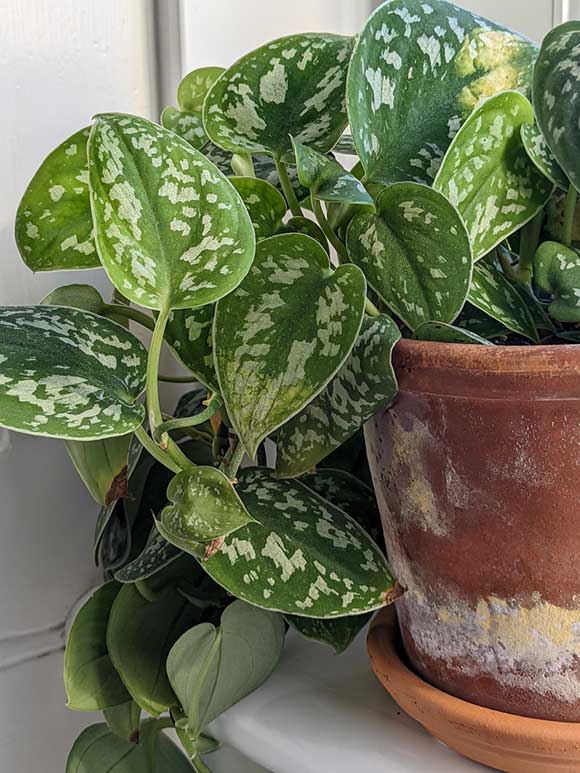
Potting and Repotting
Pothos do best when transplanted in the spring when plant growth resumes but can be repotted successfully in the summer too. It is best to avoid repotting the plant in the fall or winter when it is at rest, as it does not have the energy reserves to combat transplant shock.
Choose a pot 2 inches larger than the current pot to allow plenty of room for roots to grow. Repotting into a larger pot may cause the soil to remain soggy as the roots will not be able to absorb all the water from large amounts of soil.
Learn How to Propagate a Pothos in Water (Easy Steps)
Pruning or Pinching
Pothos do not need pruning other than to remove dead leaves. However, if your pothos produces long vines with long internodes (the area of the stem between leaves), you may want to pinch out the new leaves to force new growth along the vine.
FAQs
Why does my pothos have yellow leaves?
Leaves do not live forever. Older leaves turn yellow and die and are replaced by new leaves regularly. A few yellowed leaves are normal. However, if young leaves turn yellow, it may be a sign your pothos is over or under-watered, is getting too much light, has been over-fertilized, or is suffering from other stress. Cold or hot drafts from the central air system can stress your plant and result in yellowing leaves.
Can yellow pothos leaves turn green again?
Yellow leaves are dead and cannot be revived. They will not turn green again. Remove the yellow leaves and correct the conditions (inconsistent watering, drafts, or too much sunlight) causing the yellow leaves, and your pothos will begin to send out new green leaves.
How do I know if my pothos is getting enough light?
While green foliage will fade and look pale and sickly, the foliage of variegated varieties will lose its variegation and turn solid green. This is the plant’s way of ensuring it has enough chlorophyll to produce energy for the plant via photosynthesis.

